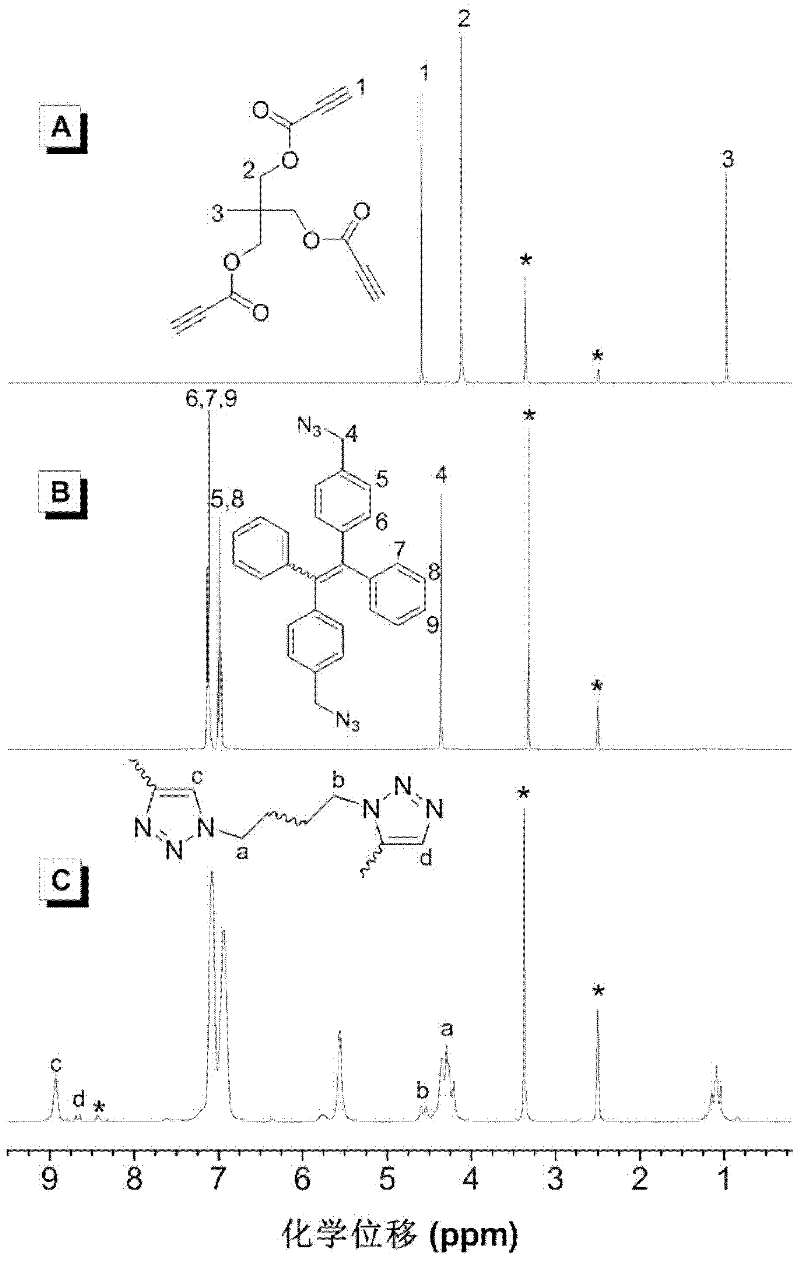Hyperbranched polytriazole formate as well as preparation method and application thereof
A technology of polytriazole formate and polymerization reaction, applied in the fields of polymer chemistry and material science, can solve the problems of affecting the biological and optoelectronic properties of polymers, difficult to remove copper catalysts, poor polymer solubility, etc. Effects of functional group compatibility, elimination of cytotoxicity, good processability
- Summary
- Abstract
- Description
- Claims
- Application Information
AI Technical Summary
Problems solved by technology
Method used
Image
Examples
Embodiment 1
[0040] (1) Synthesis of the first monomer containing a binary azide group
[0041] Add 9.81g (50mmol) of 4-methylbenzophenone and 6.54g (100mmol) of zinc powder into a 250mL two-necked flask, vacuum three times with nitrogen, add 100mL of tetrahydrofuran, and add 5.56mL of titanium tetrachloride dropwise under ice-cooling (50mmol), after the reaction system was returned to room temperature, heated to reflux for 12h, cooled, filtered, and spin-dried, the resulting crude product was separated and purified by a chromatographic column, and dried in vacuo to obtain 8.59g (95.3% yield) of a white solid, which was first intermediate. 1 H NMR (400MHz, CDCl 3 ), δ(TMS, ppm): 7.81(d, 2H), 7.74(d, 2H), 7.54(t, 1H), 7.08(m, 10H), 6.98(m, 8H), 2.23(d, 6H) .
[0042] Take 7.21g (20mmol) of the first intermediate, 7.48g (40mmol) of NBS, and 0.05g (0.2mmol) of BPO into a 250mL double-necked flask, vacuum three times with nitrogen, add 125mL of carbon tetrachloride to dissolve, heat and ref...
Embodiment 2
[0055] (1) The synthesis of the first monomer is the same as in Example 1.
[0056] (2) The second monomer The synthesis is the same as in Example 1.
[0057] (3) Preparation of hyperbranched polytriazole formate
[0058] Add 66.3mg (0.15mmol) of the first monomer, 27.6mg (0.10mmol) of the second monomer and 1mL of N,N-dimethylformamide into a 10mL polymerization tube. After the monomer is completely dissolved, raise the temperature to 60°C React for 5 hours. After the reaction solution was diluted with 5 mL of chloroform, it was added dropwise into 200 mL of rapidly stirring n-hexane to obtain a white flocculent precipitate. Stand overnight, filter and dry to obtain 73.0 mg of polymer (yield 77.7%). GPC results show: M w = 5100, PDI = 2.63. Other characterization results are the same as in Example 1.
Embodiment 3
[0060] (1) The synthesis of the first monomer is the same as in Example 1.
[0061] (2) The second monomer The synthesis is the same as in Example 1
[0062] (3) Preparation of hyperbranched polytriazole formate
[0063] Add 66.3mg (0.15mmol) of the first monomer, 33.2mg (0.12mmol) of the second monomer and 0.5mL N,N-dimethylformamide into a 10mL polymerization tube, and after the monomer is completely dissolved, heat up to 60 °C for 12 hours. After the reaction solution was diluted with 5 mL of chloroform, it was added dropwise into 200 mL of rapidly stirring n-hexane to obtain a white flocculent precipitate. Stand overnight, filter and dry to obtain 82.4 mg of polymer (yield 84.7%). GPC results show: M w = 13000, PDI = 5.27. Other characterization results are the same as in Example 1.
PUM
| Property | Measurement | Unit |
|---|---|---|
| molecular weight distribution | aaaaa | aaaaa |
Abstract
Description
Claims
Application Information
 Login to View More
Login to View More - R&D
- Intellectual Property
- Life Sciences
- Materials
- Tech Scout
- Unparalleled Data Quality
- Higher Quality Content
- 60% Fewer Hallucinations
Browse by: Latest US Patents, China's latest patents, Technical Efficacy Thesaurus, Application Domain, Technology Topic, Popular Technical Reports.
© 2025 PatSnap. All rights reserved.Legal|Privacy policy|Modern Slavery Act Transparency Statement|Sitemap|About US| Contact US: help@patsnap.com



